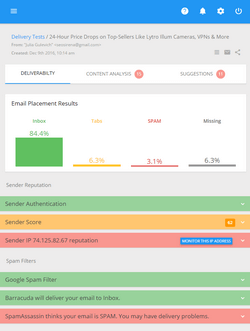Optimizing Email Delivery for AOL Users
If your mailing list contains a considerable amount of AOL subscribers, it’s important for you to be aware of the AOL service and email software specific features. You should get familiar with how AOL handles incoming email messages to be able to tailor your newsletter and overall email marketing process to the AOL specific requirements and issues. Below is a list of what you should take into account.
1. Email Design
1.1. Message Format
AOL blocks the emails if they include bad links or HTML code, such as:
http://11.78.566.123/index.html
or
<a href: http://domain.com/order.html>Buy Now!/a>
There is also a message format called “AOL Rich Text Format.” It’s a simplified HTML format that uses standard HTML features such as bold, italics, and links. For AOL users, plain text or HTML format without images are preferable and result in higher response rate.
1.2. Message Sender Field
AOL limits the From field to approximately 16 characters. AOL doesn’t show the “friendly” From field but the email address itself. For example:
From: G-Lock Software
AOL shows as:
From: support@glocksof
1.3. Message Subject Line
The Subject line in AOL is limited to about 50 characters. If your Subject is longer, it will be truncated for AOL recipients. Due to an “unfriendly” Sender line and limited space, make sure that you identify your company in the Subject line and convey the key information within the allotted space.
1.4. Message Content
Because AOL recipients can easily flag your email as spam, avoid any suspicious and ambiguous content. Simplicity and clarity are two rules to keep in mind. For AOL recipients, consider creating a shorter version of the email that will fit the tiny AOL preview window. If you create a HTML email with images, a postcard format is the best choice. For text or RTF format, make sure the most important links and calls to action are clearly visible and stand out above everything. If you have a web version of the email, provide a link to it in the text version.
2. Email Delivery
2.1. Sending Time
As the study showed that most AOL users checked email at home, optimal send times might be early mornings, evenings, or even weekends. If you’re targeting students or housewives, daytime hours would probably be the best. Try emailing at different days and times to find out what approach is most effective.
2.2. AOL Whitelist
AOL filtering system strictly checks email messages from unknown sources. To ensure that your emails will be delivered, apply for inclusion on the AOL whitelist. You’ll need to comply with all requirements and guidelines and fill out necessary forms. There is also the Enhanced Whitelist which is a part of the general AOL whitelist and contains email marketers who meet strict delivery standards. The messages from those senders are displayed with the images and links enabled by default. Whitelisted senders are automatically added to the enhanced whitelist and stay there as long as they meet AOL’s complaint-rate threshold for a 30-day period.
2.3. Bounced Emails
Maintaining a list of valid email addresses is mandatory. If a list consistently generates a bounce rate higher than 10%, AOL may reject connections from such senders. Don’t try to resend hard bounce emails just in case. Resending to bad emails addresses, plus a high volume of spam complaints, will result in your email being blocked by AOL.
2.4. Spam Complaints
AOL users can easily click on “Report Spam” button so even the most accurate email marketers may receive spam complaints. AOL provides a Feedback Loop for high-volume senders. It records the information about each spam complaint it receives from the messages and will notify you when recipients click the spam button for any of your messages. You should monitor your AOL spam complaint rate for each message, and if the complaint rate consistently exceeds the AOL’s acceptable threshold, revise your opt-in process or send a confirmation message to your AOL subscribers.
2.5. Sender Policy Framework (SPF)
AOL endorsed the Sender Policy Framework (SPF) and asks whitelist members to set up SPF records. Senders who don’t establish an SPF record will see their whitelist entries expire.
2.6. Reverse DNS
AOL requires that the sender’s mail server has Reverse DNS set up correctly or the messages may be blocked.
The bottom line: If your list contains a considerable amount of AOL users (say 10% and more), consider developing separate versions of your email for these challenging recipients. At minimum, create a Subject line that is shorter in length and identifies your company. In addition, take time to develop and test both plain text and HTML versions of your newsletter. Better yet, let AOL subscribers choose which version they would prefer to receive.
Table of contents | Page list for this chapter | Next page

